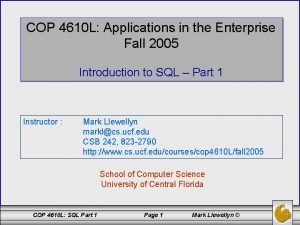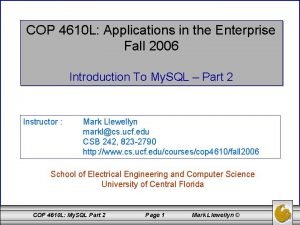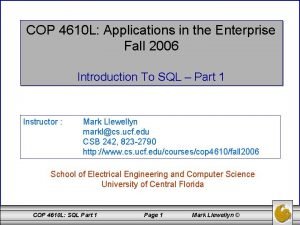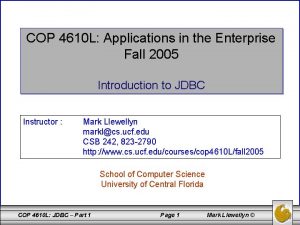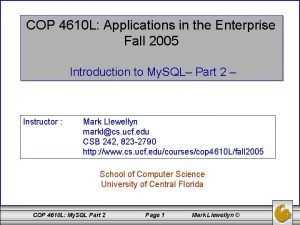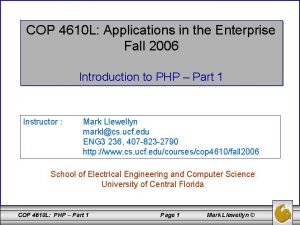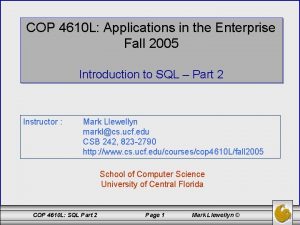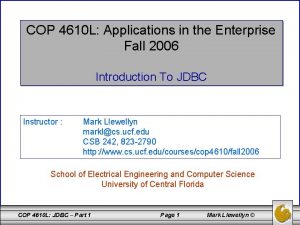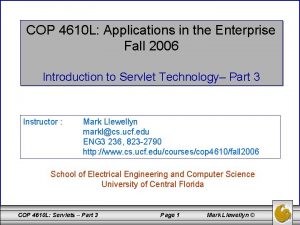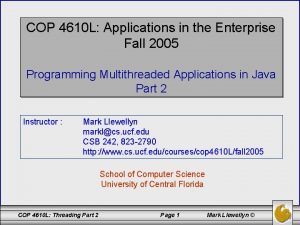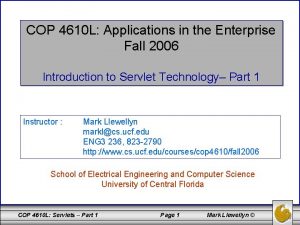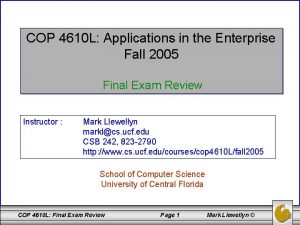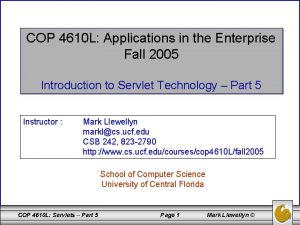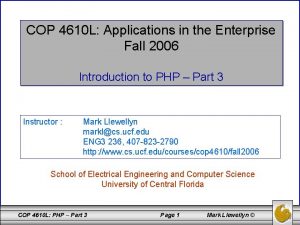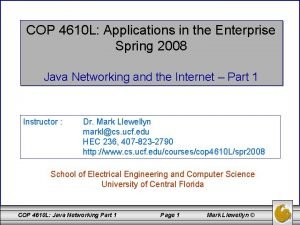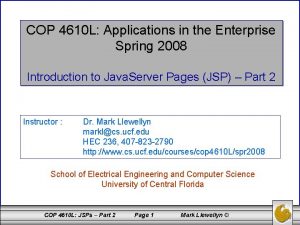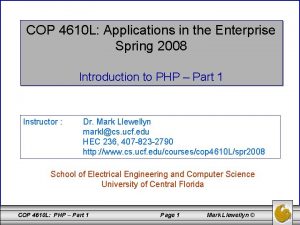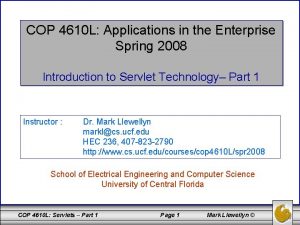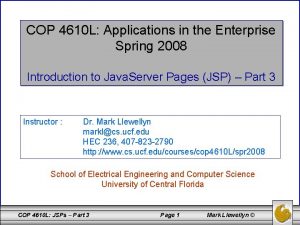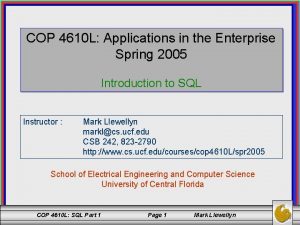COP 4610 L Applications in the Enterprise Fall














































- Slides: 46

COP 4610 L: Applications in the Enterprise Fall 2005 Introduction to Java. Server Pages (JSP) – Part 3 Instructor : Mark Llewellyn markl@cs. ucf. edu CSB 242, (407)823 -2790 http: //www. cs. ucf. edu/courses/cop 4610 L/fall 2005 School of Computer Science University of Central Florida COP 4610 L: JSPs – Part 3 Page 1 Mark Llewellyn ©

A JSPs Conversion To A Servlet • As shown in the diagram of the lifecycle of a JSP shown in part 2 (page 2), a JSP is converted into a servlet during execution. • While the converted servlet looks very similar in nature to those we have already seen, there are some differences. • Within Tomcat, the servlet version of the JSP is stored in the work directory (see part 2, page 12). • The exact directory within the work directory depends in part on your Tomcat set-up and in part on your web-application structure. The next slide illustrates the location of the servlet files that were generated for the Compute. Loan. jsp and Compute. Loan 2. jsp applications that appeared in part 2 of the notes on pages 7 and 13 respectively. COP 4610 L: JSPs – Part 3 Page 2 Mark Llewellyn ©

Servlet Versions of JSPs in Tomcat Directory location of the servlet files The servlet files corresponding to the JSPs from the loan webapplication example COP 4610 L: JSPs – Part 3 Page 3 Mark Llewellyn ©

The Converted JSP - Servlet Version package org. apache. jsp; import javax. servlet. *; import javax. servlet. http. *; import javax. servlet. jsp. *; Compute. Loan Note that this package is reflected in the location shown in the previous slide. public final class Compute. Loan_jsp extends org. apache. jasper. runtime. Http. Jsp. Base implements org. apache. jasper. runtime. Jsp. Source. Dependent { private static java. util. Vector _jspx_dependants; public java. util. List get. Dependants() { return _jspx_dependants; } public void _jsp. Service(Http. Servlet. Request request, Http. Servlet. Response response) throws java. io. IOException, Servlet. Exception { Jsp. Factory _jspx. Factory = null; Page. Context page. Context = null; Http. Session session = null; Servlet. Context application = null; Servlet. Config config = null; Jsp. Writer out = null; Object page = this; COP 4610 L: JSPs – Part 3 Page 4 Mark Llewellyn ©

Object page = this; Jsp. Writer _jspx_out = null; Page. Context _jspx_page_context = null; try { _jspx. Factory = Jsp. Factory. get. Default. Factory(); response. set. Content. Type("text/html"); page. Context = _jspx. Factory. get. Page. Context(this, request, response, null, true, 8192, true); _jspx_page_context = page. Context; application = page. Context. get. Servlet. Context(); config = page. Context. get. Servlet. Config(); session = page. Context. get. Session(); out = page. Context. get. Out(); _jspx_out = out; Begin original HTML output from out. write("<!-- Compute. Loan. jsp -->rn"); the JSP. out. write("<html>rn"); out. write("<head>rn"); out. write("<title>Compute. Loan</title>rn"); out. write("</head><body bgcolor=white background=images/background. jpg lang=EN-US link=blue vlink=bluern"); out. write("style='tab-interval: . 5 in'>rn"); double loan. Amount = Double. parse. Double( request. get. Parameter("loan. Amount")); double annual. Interest. Rate = Double. parse. Double(request. get. Parameter("annual. Interest. Rate")); double number. Of. Years = Integer. parse. Int(request. get. Parameter("number. Of. Years")); double monthly. Interest. Rate = annual. Interest. Rate / 1200; COP 4610 L: JSPs – Part 3 Page 5 Mark Llewellyn ©

double monthly. Payment = loan. Amount * monthly. Interest. Rate / (1 - 1 / Math. pow(1 + monthly. Interest. Rate, number. Of. Years * 12)); double total. Payment = monthly. Payment * number. Of. Years * 12; out. write("rn"); out. write("<b><font size = 7> Loan Details </b></font> rn"); out. write("<font size = 5>rn"); out. write("Loan Amount: rn"); out. print( loan. Amount ); out. write("rn"); out. write("Annual Interest Rate: rn"); out. print( annual. Interest. Rate ); out. write("rn"); out. write("Number of Years: rn"); out. print( number. Of. Years ); out. write("rn"); out. write("<b>rn"); out. write("Monthly Payment: rn"); out. print( monthly. Payment ); out. write("rn"); out. write("Total Payment: rn"); out. print( total. Payment ); out. write("rn"); out. write("</b>rn"); out. write("</body>rn"); out. write("</html>"); } catch (Throwable t) { if (!(t instanceof Skip. Page. Exception)){ out = _jspx_out; if (out != null && out. get. Buffer. Size() != 0) out. clear. Buffer(); if (_jspx_page_context != null) _jspx_page_context. handle. Page. Exception(t); } } finally { if (_jspx. Factory != null) _jspx. Factory. release. Page. Context(_jspx_page_context); }}}} COP 4610 L: JSPs – Part 3 Page 6 Mark Llewellyn ©

The Converted JSP - Servlet Version package org. apache. jsp; import javax. servlet. *; javax. servlet. http. *; javax. servlet. jsp. *; code. Loan; Compute. Loan 2 Import the Loan class in package code public final class Compute. Loan 2_jsp extends org. apache. jasper. runtime. Http. Jsp. Base implements org. apache. jasper. runtime. Jsp. Source. Dependent { private static java. util. Vector _jspx_dependants; public java. util. List get. Dependants() { return _jspx_dependants; } public void _jsp. Service(Http. Servlet. Request request, Http. Servlet. Response response) throws java. io. IOException, Servlet. Exception { Jsp. Factory _jspx. Factory = null; Page. Context page. Context = null; Http. Session session = null; Servlet. Context application = null; Servlet. Config config = null; Jsp. Writer out = null; COP 4610 L: JSPs – Part 3 Page 7 Mark Llewellyn ©

Object page = this; Jsp. Writer _jspx_out = null; Page. Context _jspx_page_context = null; try { _jspx. Factory = Jsp. Factory. get. Default. Factory(); response. set. Content. Type("text/html"); page. Context = _jspx. Factory. get. Page. Context(this, request, response, null, true, 8192, true); _jspx_page_context = page. Context; application = page. Context. get. Servlet. Context(); config = page. Context. get. Servlet. Config(); session = page. Context. get. Session(); out = page. Context. get. Out(); Begin the HTML content from the _jspx_out = out; original Compute. Load. jsp file now constructed from within the servlet out. write("<!-- Compute. Loan 2. jsp -->rn"); (i. e. , Java). out. write("<html>rn"); out. write("<head>rn"); out. write("<title>Compute. Loan</title>rn"); out. write("</head><body bgcolor=white background=images/background. jpg lang=EN-US link=blue vlink=bluern"); out. write("style='tab-interval: . 5 in'>rn"); out. write("rn"); double loan. Amount = Double. parse. Double( request. get. Parameter("loan. Amount")); double annual. Interest. Rate = Double. parse. Double(request. get. Parameter("annual. Interest. Rate")); int number. Of. Years = Integer. parse. Int(request. get. Parameter("number. Of. Years")); COP 4610 L: JSPs – Part 3 Page 8 Mark Llewellyn ©

Loan loan = new Loan (annual. Interest. Rate, number. Of. Years, loan. Amount); out. write("rn"); out. write("<b><font size = 7> Loan Details </b></font> rn"); out. write("<font size = 5>rn"); out. write("Loan Amount: rn"); out. print( loan. Amount ); out. write("rn"); out. write("Annual Interest Rate: rn"); out. print( annual. Interest. Rate ); out. write("rn"); out. write("Number of Years: rn"); out. print( number. Of. Years ); out. write("rn"); out. write("<b>rn"); out. write("Monthly Payment: rn"); out. print( loan. monthly. Payment() ); out. write("rn"); out. write("Total Payment: rn"); out. print( loan. total. Payment() ); out. write("rn"); out. write("</b>rn"); out. write("</body>rn"); out. write("</html>"); } catch (Throwable t) { if (!(t instanceof Skip. Page. Exception)){ out = _jspx_out; if (out != null && out. get. Buffer. Size() != 0) out. clear. Buffer(); if (_jspx_page_context != null) _jspx_page_context. handle. Page. Exception(t); } } finally { if (_jspx. Factory != null) _jspx. Factory. release. Page. Context(_jspx_page_context); } } } COP 4610 L: JSPs – Part 3 Page 9 Mark Llewellyn ©

<jsp: set. Property> Action • Action <jsp: set. Property> sets Java. Bean property values and is most useful for mapping request parameter values to Java. Bean properties. • Request parameters can be used to set properties of primitive types boolean, byte, char, short, int, long, float and double as well as java. lang types String, Boolean, Byte, Character, Short, Integer, Long, Float, and Double. • The table on the following page summarizes the attributes of this action. COP 4610 L: JSPs – Part 3 Page 10 Mark Llewellyn ©

<jsp: set. Property> Action Attribute name Description The ID of the Java. Bean for which a property (or properties) will be set. property The name of the property to set. Specifying “*” for this attribute specifies that the JSP should match the request parameters to the properties of the bean. For each request parameter that matches (i. e. , the name of the request parameter is identical to the bean’s property name), the corresponding property in the bean is set to the value of the parameter. If the value of the request parameter is “”, the property value in the bean remains unchanged. param If the request parameter names do not match bean property names, this attribute can be used to specify which request parameter should be used to obtain the value for a specific bean property. This attribute is optional. If this attribute is omitted, the request parameter names must match the bean property names. value The value to assign to a bean property. The value typically is the result of a JSP expression. This attribute is particularly useful for setting bean properties that cannot be set using request parameters. This attribute is optional. If this attribute is omitted, the Java. Bean property must be of a type that can be set using request parameters. COP 4610 L: JSPs – Part 3 Page 11 Mark Llewellyn ©

JSP Directives • Directives are messages to the JSP container that enable the programmer to specify page settings, such as, the error page to invoke if an error occurs (page directive), including content from other resources (include directive), and to specify custom-tag libraries for use in a JSP (taglib directive). • Directives are delimited by <%@ and %> and are processed at translation time. As such, directives do not produce any immediate output, because they are processed before the JSP accepts any requests. • For our purposes here, the most important of these is the page directive, which we will make use of in the final example JSP. Some of the attributes of the page directive are shown on the next page. COP 4610 L: JSPs – Part 3 Page 12 Mark Llewellyn ©

JSP Page Directive Attributes Attribute Description import Specifies a comma-separated list of fully qualified type names and/or packages that will be used in the current JSP. error. Page Any exceptions in the current page that are not caught are sent to the error page for processing. The error-page implicit object exception references the original exception. extends Specifies the class from which the translated JSP can inherit. This attribute must be a fully qualified class name. COP 4610 L: JSPs – Part 3 Page 13 Mark Llewellyn ©

<jsp: use. Bean> Action • Action <jsp: use. Bean> enables a JSP to manipulate a Java object. This action creates a Java object or locates an existing object for use in the JSP. • The table on the following page summarizes the attributes of this action. • If attributes class and bean. Name are not specified, the JSP container attempts to locate an existing object of the type specified in attribute type. • Like JSP implicit objects, objects specified with this action have scope – page, request, session, or application – which indicates where they can be used in a web application. (Recall that objects with page scope are only accessible by the page in which they are defined. For example, all JSPs that process a single request can access an object in request scope. ) COP 4610 L: JSPs – Part 3 Page 14 Mark Llewellyn ©

<jsp: use. Bean> Action Attribute Description id The name used to manipulate the Java object with actions <jsp: set. Property> and <jsp: get. Property>. A variable of this name is also declared for use in JSP scripting elements. Case sensitive. scope class bean. Name type The scope in which the Java object is accessible – page, request, session, or application. The default scope is page. The fully qualified class name of the Java object. The name of the Java. Bean that can be used with method instantiate of class java. beans. Beans to load a Java. Bean into memory. The type of the Java. Bean. This can be the same type as the class attribute, a superclass of that type, or an interface implemented by that type. The default value is the same as for attribute class. A Class. Cast. Exception occurs if the Java object is not of the type specified with attribute type. COP 4610 L: JSPs – Part 3 Page 15 Mark Llewellyn ©

A JSP Using <jsp: use. Bean> Action • A common feature on many web sites is to place rotating advertisements on their webpages. Each visit to one of these pages results in a different advertisement being displayed in the user’s web browser. Typically, when you click on the advertisement (or picture of a product) you are redirected to the website of the company that placed the advertisement or to the page that more completely describes the product. • The next example illustrates a similar scenario, by rotating through a series of pictures (click the refresh button of your browser to simulate multiple logins or login from different browsers). In this example, I set it up to rotate through some pictures of some of my toys. If you click on a picture…you’ll be redirected to the manufacturer’s web page. COP 4610 L: JSPs – Part 3 Page 16 Mark Llewellyn ©

A JSP Using the <jsp: use. Bean> Action // Rotator. java // A Java. Bean that rotates pictures. package com. cop 4610. jsp. beans; public class Rotator { private String images[] = { "images/image 1. jpg", "images/image 2. jpg", "images/image 3. jpg", "images/image 4. jpg", "images/image 5. jpg" }; private String links[] = { "http: //www. eddymerckx. be", "http: //www. competitivecyclist. com", "http: //www. bianchi-usa. com", "http: //www. colnago. it", "http: //www. cometkartsales. com" }; private int selected. Index = 0; // returns image file name for current ad public String get. Image() { return images[ selected. Index ]; } // end method get. Image COP 4610 L: JSPs – Part 3 //continue here -- returns the URL for corresponding Web site public String get. Link() { return links[ selected. Index ]; } // end method get. Link // update selected. Index so next calls to get. Image and // get. Link return a different picture public void next. Pic() { selected. Index = ( selected. Index + 1 ) % images. length; } // end method next. Pic } // end class Rotator Page 17 Mark Llewellyn ©

<? xml version = "1. 0"? > <!DOCTYPE html PUBLIC "-//W 3 C//DTD XHTML 1. 0 Strict//EN" "http: //www. w 3. org/TR/xhtml 1/DTD/xhtml 1 -strict. dtd"> <!-- picturerotator. jsp --> <jsp: use. Bean id = "rotator" scope = "session" class = "com. cop 4610. jsp. beans. Rotator" /> <html xmlns = "http: //www. w 3. org/1999/xhtml"> <head> <title>Picture. Rotator Example</title> <style type = "text/css">. big { font-family: helvetica, arial, sans-serif; font-weight: bold; font-size: </style> <%-- update picture --%> <% rotator. next. Pic(); %> </head> <body> <p class = "big">Picture. Rotator Example</p> <a href = "<jsp: get. Property name = "rotator" property = "link" />"> picturerotator. jsp <jsp: use. Bean> action specifying id, scope, and class 2 em } <img src = "<jsp: get. Property name = "rotator" property = "image" />" alt = "picture" /> </a> </p> </body> </html> COP 4610 L: JSPs – Part 3 Page 18 Mark Llewellyn ©

First image seen in the rotation of five images. COP 4610 L: JSPs – Part 3 Page 19 Mark Llewellyn ©

Fifth and final image seen in the rotation of five images. COP 4610 L: JSPs – Part 3 Page 20 Mark Llewellyn ©

Redirected to web site by clicking on the image COP 4610 L: JSPs – Part 3 Page 21 Mark Llewellyn ©

More Details On Using Beans • The Rotator bean has three elements: get. Image, get. Link, and next. Pic. – Method get. Image returns the image file name for the picture to be displayed. – Method get. Link returns the hyperlink to the manufacturer/supplier of the “toy”. – Method next. Pic updates the Rotator so that the next calls to get. Image and get. Link will return information for a different picture. • Methods get. Image and get. Link each represent a read-only Java. Bean property – image and link, respectively. These are read-only properties because no set methods are provided to change their values. • Rotator keeps track of the current picture with its selected. Index variable, which is updated by invoking method next. Pic. COP 4610 L: JSPs – Part 3 Page 22 Mark Llewellyn ©

More Details On Using Beans • (cont. ) Java. Beans were originally intended to be manipulated visually in visual development environments (often called builder tools or IDEs). • Builder tools that support beans provide programmers with tremendous flexibility by allowing for the reuse and integration of existing disparate components that, in many cases, were never intended to be used together. • When used in an IDE, Java. Beans adhere to the following coding conventions: 1. Implements the Serializable interface. 2. Provides a public no-argument (default) constructor. 3. Provides get and/or set methods for properties (which are normally implemented as fields. ) COP 4610 L: JSPs – Part 3 Page 23 Mark Llewellyn ©

More Details On Using Beans • When used on the server side, such as within a JSP or a servlet, Java. Beans are less restricted. – • (cont. ) Notice for example, that the Rotator bean does not implement the Serializable interface because there is no need to save and load the Rotator bean as a file. The JSP picturerotator. jsp (see page 6) obtains a reference to an instance of class Rotator. The id for the bean is rotator. The JSP uses this name to manipulate the bean. The scope of the object is session, so that every client will see the same sequence of pictures during their browsing sessions. COP 4610 L: JSPs – Part 3 Page 24 Mark Llewellyn ©

More Details On Using Beans (cont. ) • When picturerotator. jsp receives a request from a new client, the JSP container creates the bean and stores it in that client’s session (an Http. Session object). • In each request to this JSP, the rotator reference which is created is used to invoke the Rotator bean’s next. Pic method. Therefore, each request will receive the next picture selected by the Rotator bean. • Notice the two <jsp: get. Property> actions in the picturerotator. jsp file. One of these obtains the link property value from the bean, the other obtains the image property value. – Action <jsp: get. Property> has two attributes: name and property, which specify the bean object to manipulate and the property to get. COP 4610 L: JSPs – Part 3 Page 25 Mark Llewellyn ©

More Details On Using Beans • (cont. ) Action <jsp: get. Property> has two attributes: name and property, which specify the bean object to manipulate and the property to get. – If the Java. Bean object uses standard Java. Bean naming conventions, the method used to obtain the link property value from the bean should be get. Link. – Action <jsp: get. Property> invokes get. Link on the bean referenced with rotator, converts the return value into a String and outputs the String as a part of the response to the client. COP 4610 L: JSPs – Part 3 Page 26 Mark Llewellyn ©

More Details On Using Beans • (cont. ) The link and image properties can also be obtained with JSP expressions. – The action <jsp: get. Property> (see page 6 for location, the line looks like: <a href = "<jsp: get. Property name = "rotator" property = "link" />">) could be replaced with the expression: <%= rotator. get. Link() %> – Similarly, the action <jsp: get. Property> (see page 6 for location, the line looks like: <img src = "<jsp: get. Property name = "rotator" property = "image" />" alt = "picture" />) could be replaced with the expression: <%= rotator. get. Image() %> • However, the benefit of using actions is that someone who is unfamiliar with Java can be told the name of a property and the name of a bean, and it is the action’s responsibility to invoke the appropriate methods. The Java programmer’s job is to create a bean that supports the capabilities required by the page designer. COP 4610 L: JSPs – Part 3 Page 27 Mark Llewellyn ©

Final JSP Example - Guest. Book • Our final JSP example will illustrate many of the techniques that we’ve covered in dealing with JDBC, servlets, and JSPs. • This example constructs a simple My. SQL database to maintain a guest book that includes a guest’s first name, last name, and email address. – • Once a guest enters their name into the guestbook, they will see a webpage containing all the guests in the guest book. Each email address is displayed as a hyperlink that makes it possible for guests to send email to another guest. This example illustrates the <jsp: set. Property> action, the JSP page directive, JSP error pages, and using JDBC from a JSP. COP 4610 L: JSPs – Part 3 Page 28 Mark Llewellyn ©

Guest. Bean. java // Java. Bean to store data for a guest in the guest book. package com. cop 4610. jsp. beans; This Java. Bean maintains information for one guest. public class Guest. Bean { private String first. Name; private String last. Name; private String email; // set the guest's first name public void set. First. Name( String name ) { first. Name = name; } // end method set. First. Name // get the guest's first name public String get. First. Name() { return first. Name; } // end method get. First. Name COP 4610 L: JSPs – Part 3 Page 29 Mark Llewellyn ©

Guest. Bean. java (cont. ) // set the guest's last name public void set. Last. Name( String name ) { last. Name = name; } // end method set. Last. Name // get the guest's last name public String get. Last. Name() { return last. Name; } // end method get. Last. Name // set the guest's email address public void set. Email( String address ) { email = address; } // end method set. Email // get the guest's email address public String get. Email() { return email; } // end method get. Email } // end class Guest. Bean COP 4610 L: JSPs – Part 3 Page 30 Mark Llewellyn ©

Guest. Data. Bean. java // Class Guest. Data. Bean makes a database connection and supports // inserting and retrieving data from the database. This Java. Bean performs the package com. cop 4610. jsp. beans; import database access on behalf of the guest. Book. Login. jsp java. sql. SQLException; javax. sql. rowset. Cached. Row. Set; java. util. Array. List; com. sun. rowset. Cached. Row. Set. Impl; // Cached. Row. Set implementation public class Guest. Data. Bean { private Cached. Row. Set row. Set; This application uses the Cached. Row. Set data model rather than the Table. Set from our earlier JDBC application example. // construct Titles. Bean object public Guest. Data. Bean() throws Exception { // load the My. SQL driver Class. for. Name( "com. mysql. jdbc. Driver" ); Load JDBC driver and connect to database // specify properties of Cached. Row. Set row. Set = new Cached. Row. Set. Impl(); row. Set. set. Url( "jdbc: mysql: //localhost/guestbook" ); row. Set. set. Username( "root" ); row. Set. set. Password( "root" ); COP 4610 L: JSPs – Part 3 Page 31 Mark Llewellyn ©

Guest. Data. Bean. java (cont. ) // obtain list of titles row. Set. set. Command( "SELECT first. Name, last. Name, email FROM guests" ); row. Set. execute(); } // end Guest. Data. Bean constructor // return an Array. List of Guest. Beans public Array. List< Guest. Bean > get. Guest. List() throws SQLException { Array. List< Guest. Bean > guest. List = new Array. List< Guest. Bean >(); row. Set. before. First(); // move cursor before the first row // get row data while ( row. Set. next() ) { Guest. Bean guest = new Guest. Bean(); guest. set. First. Name( row. Set. get. String( 1 ) ); guest. set. Last. Name( row. Set. get. String( 2 ) ); guest. set. Email( row. Set. get. String( 3 ) ); guest. List. add( guest ); } // end while COP 4610 L: JSPs – Part 3 Page 32 Mark Llewellyn ©

Guest. Data. Bean. java return guest. List; } // end method get. Guest. List // insert a guest in guestbook database public void add. Guest( Guest. Bean guest ) throws SQLException { row. Set. move. To. Insert. Row(); // move cursor to the insert row // update three columns of the insert row. Set. update. String( 1, guest. get. First. Name() ); row. Set. update. String( 2, guest. get. Last. Name() ); row. Set. update. String( 3, guest. get. Email() ); row. Set. insert. Row(); // insert row to row. Set. move. To. Current. Row(); // move cursor to the current row. Set. accept. Changes(); // propagate changes to database } // end method add. Guest } // end class Guest. Data. Bean COP 4610 L: JSPs – Part 3 Page 33 Mark Llewellyn ©

Guest. Book. Login. jsp <? xml version = "1. 0"? > <!DOCTYPE html PUBLIC "-//W 3 C//DTD XHTML 1. 0 Strict//EN" "http: //www. w 3. org/TR/xhtml 1/DTD/xhtml 1 -strict. dtd"> <!-- guest. Book. Login. jsp --> <%-- page settings --%> <%@ page error. Page = "guest. Book. Error. Page. jsp" %> <%-- beans used in this JSP --%> <jsp: use. Bean id = "guest" scope = "page" class = "com. cop 4610. jsp. beans. Guest. Bean" /> <jsp: use. Bean id = "guest. Data" scope = "request" class = "com. cop 4610. jsp. beans. Guest. Data. Bean" /> <html xmlns = "http: //www. w 3. org/1999/xhtml"> <head> <title>Guest Book Login</title> <style type = "text/css"> body { font-family: tahoma, helvetica, arial, sans-serif; } COP 4610 L: JSPs – Part 3 Guest. Book. Login. jsp is a modified version of our welcome 1. jsp and welcome 1 servlet that we’ve already seen. It displays a form that the guest uses to enter their information. When the form is submitted, Guest. Book. Login. jsp is requested again so that it can ensure that all of the data is entered. If not, the form is regenerated until the guest enters all information. If all information is entered, then this JSP forwards the request to guest. Book. View. jsp to display the contents of the guest book. All uncaught exceptions are forwarded to guest. Book. Error. Page. jsp for processing. Page 34 Mark Llewellyn ©

Guest. Book. Login. jsp table, tr, td { font-size: 1. 4 em; border: 3 px groove; padding: 5 px; background-color: #dddddd; } </style> </head> <body> <jsp: set. Property name = "guest" property = "*" /> <% // start scriptlet if ( guest. get. First. Name() == null || guest. get. Last. Name() == null || guest. get. Email() == null ) { %> <%-- end scriptlet to insert fixed template data --%> <form method = "post" action = "guest. Book. Login. jsp"> <p>Enter your first name, last name and email address to register in our guest book. </p> <table> <tr> <td>First name</td> <input type = "text" name = "first. Name" /> </td> </tr> COP 4610 L: JSPs – Part 3 Page 35 (cont. ) <jsp: set. Property> action Mark Llewellyn ©

Guest. Book. Login. jsp (cont. ) <tr> <td>Last name</td> <input type = "text" name = "last. Name" /> </td> </tr> <td>Email</td> <input type = "text" name = "email" /> </td> </tr> <td colspan = "2"> <input type = "submit" value = "Submit" /> </td> </tr> </table> </form> <% // continue scriptlet } // end if Once the guest has entered their else information into the database, the { guest. Book. View is generated via guest. Data. add. Guest( guest ); the <jsp: forward> action which %> <%-- end scriptlet to insert jsp: forward action --%> invokes the guest. Book. View JSP. <%-- forward to display guest book contents --%> <jsp: forward page = "guest. Book. View. jsp" /> <% // continue scriptlet } // end else %> <%-- end scriptlet --%> </body> </html> COP 4610 L: JSPs – Part 3 Page 36 Mark Llewellyn ©

Guest. Book. View. jsp <? xml version = "1. 0"? > <!DOCTYPE html PUBLIC "-//W 3 C//DTD XHTML 1. 0 Strict//EN" "http: //www. w 3. org/TR/xhtml 1/DTD/xhtml 1 -strict. dtd"> <!-- guest. Book. View. jsp --> <%-- page settings --%> <%@ page error. Page = "guest. Book. Error. Page. jsp" %> <%@ page import = "java. util. *" %> <%@ page import = "com. cop 4610. jsp. beans. *" %> These three page directives specify that the error page for this JSP is guest. Book. Error. Page. jsp, that classes from package java. util are used in this JSP, and classes from the package com. cop 4610. jsp. beans are also used. <%-- Guest. Data. Bean to obtain guest list --%> <jsp: use. Bean id = "guest. Data" scope = "request" class = "com. cop 4610. jsp. beans. Guest. Data. Bean" /> <html xmlns = "http: //www. w 3. org/1999/xhtml"> <head> <title>Guest List</title> <style type = "text/css"> body { font-family: tahoma, helvetica, arial, sans-serif; } COP 4610 L: JSPs – Part 3 Page 37 Mark Llewellyn ©

Guest. Book. View. jsp (cont. ) table, tr, td, th { text-align: center; font-size: 1. 4 em; border: 3 px groove; padding: 5 px; background-color: #dddddd; } </style> </head> <body> <p style = "font-size: 2 em; ">Guest List</p> <table> <thead> <tr> <th style = "width: 100 px; ">Last name</th> <th style = "width: 100 px; ">First name</th> <th style = "width: 200 px; ">Email</th> </tr> </thead> <tbody> <% // start scriptlet List guest. List = guest. Data. get. Guest. List(); Iterator guest. List. Iterator = guest. List. iterator(); Guest. Bean guest; COP 4610 L: JSPs – Part 3 Page 38 Mark Llewellyn ©

Guest. Book. View. jsp (cont. ) while ( guest. List. Iterator. has. Next() ) { guest = ( Guest. Bean ) guest. List. Iterator. next(); %> <%-- end scriptlet; insert fixed template data --%> <tr> <td><%= guest. get. Last. Name() %></td> <td><%= guest. get. First. Name() %></td> <a href = "mailto: <%= guest. get. Email() %>"> <%= guest. get. Email() %></a> </td> </tr> <% // continue scriptlet } // end while %> <%-- end scriptlet --%> </tbody> </table> </body> </html> COP 4610 L: JSPs – Part 3 Page 39 Mark Llewellyn ©

guest. Book. Error. Page. jsp <? xml version = "1. 0"? > <!DOCTYPE html PUBLIC "-//W 3 C//DTD XHTML 1. 0 Strict//EN" "http: //www. w 3. org/TR/xhtml 1/DTD/xhtml 1 -strict. dtd"> <!-- guest. Book. Error. Page. jsp --> <%-- page settings --%> <%@ page is. Error. Page = "true" %> <%@ page import = "java. util. *" %> <%@ page import = "java. sql. *" %> <html xmlns = "http: //www. w 3. org/1999/xhtml"> <head> <title>Error!</title> <style type = "text/css">. big. Red { font-size: 2 em; color: red; font-weight: bold; </style> </head> <body> <p class = "big. Red"> <% // scriptlet to determine exception type // and output beginning of error message if ( exception instanceof SQLException ) { %> COP 4610 L: JSPs – Part 3 Page 40 } Mark Llewellyn ©

guest. Book. Error. Page. jsp (cont. ) A SQLException <% } // end if else if ( exception instanceof Class. Not. Found. Exception ) { %> A Class. Not. Found. Exception <% } // end else if else { %> A general exception <% } // end else %> <%-- end scriptlet to insert fixed template data --%> <%-- continue error message output --%> occurred while interacting with the guestbook database. </p> <p class = "big. Red"> The error message was: <%= exception. get. Message() %> </p> <p class = "big. Red">Please try again later</p> </body> </html> COP 4610 L: JSPs – Part 3 Page 41 Mark Llewellyn ©

My. SQL Database: Guestbook To run this example you will need to create the database named guestbook and the table named guests with the schema shown above. The script named “guestbookscript. sql” is on the course code page for you to use. COP 4610 L: JSPs – Part 3 Page 42 Mark Llewellyn ©

Output From Execution of Guest. Book. Login JSP (cont. ) Initial screen for client to enter information to be sent to the database. COP 4610 L: JSPs – Part 3 Page 43 Mark Llewellyn ©

Output From Execution of Guest. Book. Login JSP (cont. ) Once information is entered into the database, the guest. Book. Login JSP forwards to the Guest. Book. View JSP to display the contents of the guest book. COP 4610 L: JSPs – Part 3 Page 44 Mark Llewellyn ©

Causing An Error From Guest. Book. Login JSP Email address is the primary key and this one will be a duplicate value when the user clicks the submit button. Next page illustrates the results. COP 4610 L: JSPs – Part 3 Page 45 Mark Llewellyn ©

Causing An Error From Guest. Book. Login JSP (cont. ) Error page was generated due to the duplicate key value. COP 4610 L: JSPs – Part 3 Page 46 Mark Llewellyn ©
 Cop 1 cop 2
Cop 1 cop 2 Good cop bad cop interrogation
Good cop bad cop interrogation Ascii 224
Ascii 224 Onestart iu
Onestart iu The four major enterprise applications are
The four major enterprise applications are Putting the enterprise into the enterprise system
Putting the enterprise into the enterprise system Enterprise
Enterprise Thơ thất ngôn tứ tuyệt đường luật
Thơ thất ngôn tứ tuyệt đường luật Các châu lục và đại dương trên thế giới
Các châu lục và đại dương trên thế giới Từ ngữ thể hiện lòng nhân hậu
Từ ngữ thể hiện lòng nhân hậu Sự nuôi và dạy con của hổ
Sự nuôi và dạy con của hổ Diễn thế sinh thái là
Diễn thế sinh thái là Vẽ hình chiếu vuông góc của vật thể sau
Vẽ hình chiếu vuông góc của vật thể sau Ng-html
Ng-html Giọng cùng tên là
Giọng cùng tên là Làm thế nào để 102-1=99
Làm thế nào để 102-1=99 Lời thề hippocrates
Lời thề hippocrates Glasgow thang điểm
Glasgow thang điểm đại từ thay thế
đại từ thay thế Quá trình desamine hóa có thể tạo ra
Quá trình desamine hóa có thể tạo ra Công thức tính thế năng
Công thức tính thế năng Thế nào là mạng điện lắp đặt kiểu nổi
Thế nào là mạng điện lắp đặt kiểu nổi Dạng đột biến một nhiễm là
Dạng đột biến một nhiễm là Vẽ hình chiếu đứng bằng cạnh của vật thể
Vẽ hình chiếu đứng bằng cạnh của vật thể Biện pháp chống mỏi cơ
Biện pháp chống mỏi cơ Bổ thể
Bổ thể Phản ứng thế ankan
Phản ứng thế ankan Thiếu nhi thế giới liên hoan
Thiếu nhi thế giới liên hoan Khi nào hổ mẹ dạy hổ con săn mồi
Khi nào hổ mẹ dạy hổ con săn mồi Hát lên người ơi
Hát lên người ơi điện thế nghỉ
điện thế nghỉ Một số thể thơ truyền thống
Một số thể thơ truyền thống Trời xanh đây là của chúng ta thể thơ
Trời xanh đây là của chúng ta thể thơ Các số nguyên tố là gì
Các số nguyên tố là gì Tỉ lệ cơ thể trẻ em
Tỉ lệ cơ thể trẻ em Vẽ hình chiếu vuông góc của vật thể sau
Vẽ hình chiếu vuông góc của vật thể sau đặc điểm cơ thể của người tối cổ
đặc điểm cơ thể của người tối cổ Các châu lục và đại dương trên thế giới
Các châu lục và đại dương trên thế giới Thế nào là hệ số cao nhất
Thế nào là hệ số cao nhất Hệ hô hấp
Hệ hô hấp ưu thế lai là gì
ưu thế lai là gì Các môn thể thao bắt đầu bằng tiếng nhảy
Các môn thể thao bắt đầu bằng tiếng nhảy Tư thế ngồi viết
Tư thế ngồi viết Cái miệng nó xinh thế
Cái miệng nó xinh thế Hình ảnh bộ gõ cơ thể búng tay
Hình ảnh bộ gõ cơ thể búng tay Cách giải mật thư tọa độ
Cách giải mật thư tọa độ Tư thế ngồi viết
Tư thế ngồi viết















































